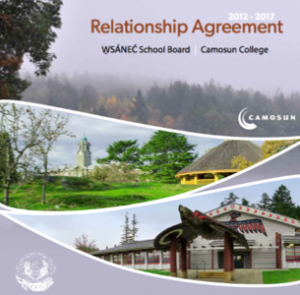Section 3: Leloo (Wolf)
Iskum (Gather)
Gathering resources to bring home and share requires a certain level of knowledge. As you paddle, your curiosities about Indigenization grow and the journey becomes less intimidating. However, Indigenization is layered and, as John Boraas stressed, “Indigenization is complex!” Accepting Indigenization and its challenges requires leadership and a commitment to the process. Indigenization cannot be explained in a single book or article, as there are numerous perspectives on it; however, there is a need to understand the why of Indigenizing the institution.
Much time and consideration must be spent asking yourself the question, Why not Indigenize? Gathering resources also means taking what you have learned and forming your perspective on Indigenization in a way that benefits others within the institution. As previously noted, perhaps the biggest challenge is getting people to understand the why of Indigenization. Many people do not know the impacts of colonization or the history of Canada in relation to Indigenous Peoples because they have not yet made the connections between assimilationist policies and practices and Indigenous Peoples.
Start at the most basic level when embarking on Indigenization, to mitigate assumptions about Indigenous Peoples. And recognize the importance of understanding your responsibility in relation to Indigenization. Corrine Michel emphasized that Indigenization is everyone’s responsibility. Responsibility for this work needs to be embedded across the institution, with many people, in order for the work to have an impact. Too often, Indigenization has been seen as the purview only of the Indigenous education department and its faculty.
From a community perspective, Kendra Underwood highlighted the nature of the partnership that the W̱SÁNEĆ Tribal School and Adult Education Centre has had with Camosun College, together offering local community and academic programming to support the educational vision of the W̱SÁNEĆ First Nations. Kendra noted that over the more than 40 years the two organizations have worked together, they have gone from a handshake to a partnership agreement to the existing relationship agreement, and a genuine interest to partner and a commitment to working in a good way continue to exist.
Kendra spoke to the nature of community partnerships and what is at their core: relationships. It is about working together to value and honour the knowledge and expertise that a First Nation brings to the table, and reciprocity in terms of the contributions that both partners make to deliver programming, especially in community-based education. Kendra’s advice for building relationships is to be honest, open, and up-front: she always deeply respects someone if they come to her to share their uncertainty and ask for recommendations. The openness, transparency, and humbleness of being unsure, but asking questions anyway, is valued and appreciated in community. The community might not know the answers, but will appreciate the humility, and there will be a willingness to support and guide or make recommendations if challenges arise during program delivery. Uncertainty will exist on both sides of the partnership; being up-front and open is the best policy.

Kendra said that many First Nation communities are approachable. Sometimes just acknowledging that we’re in unknown territory and that we’re both very humble in our approach can help us work together to overcome any obstacles or barriers that we might face. Camosun College and W̱SÁNEĆ Adult Education Centre work together to address community needs while closing the educational gaps. Other community relationships are fostered by Elder representation on advisory councils and providing Elder support for students. Events such as Camosun’s Indigenous Welcome Feast, Orange Shirt Day, and the pit cook also help bring Camosun College and local Indigenous communities together.
Media Attributions
- Relationship Agreement 2012-2017 [PDF] © Camosun College and W̱SÁNEĆ Adult Education Centre

